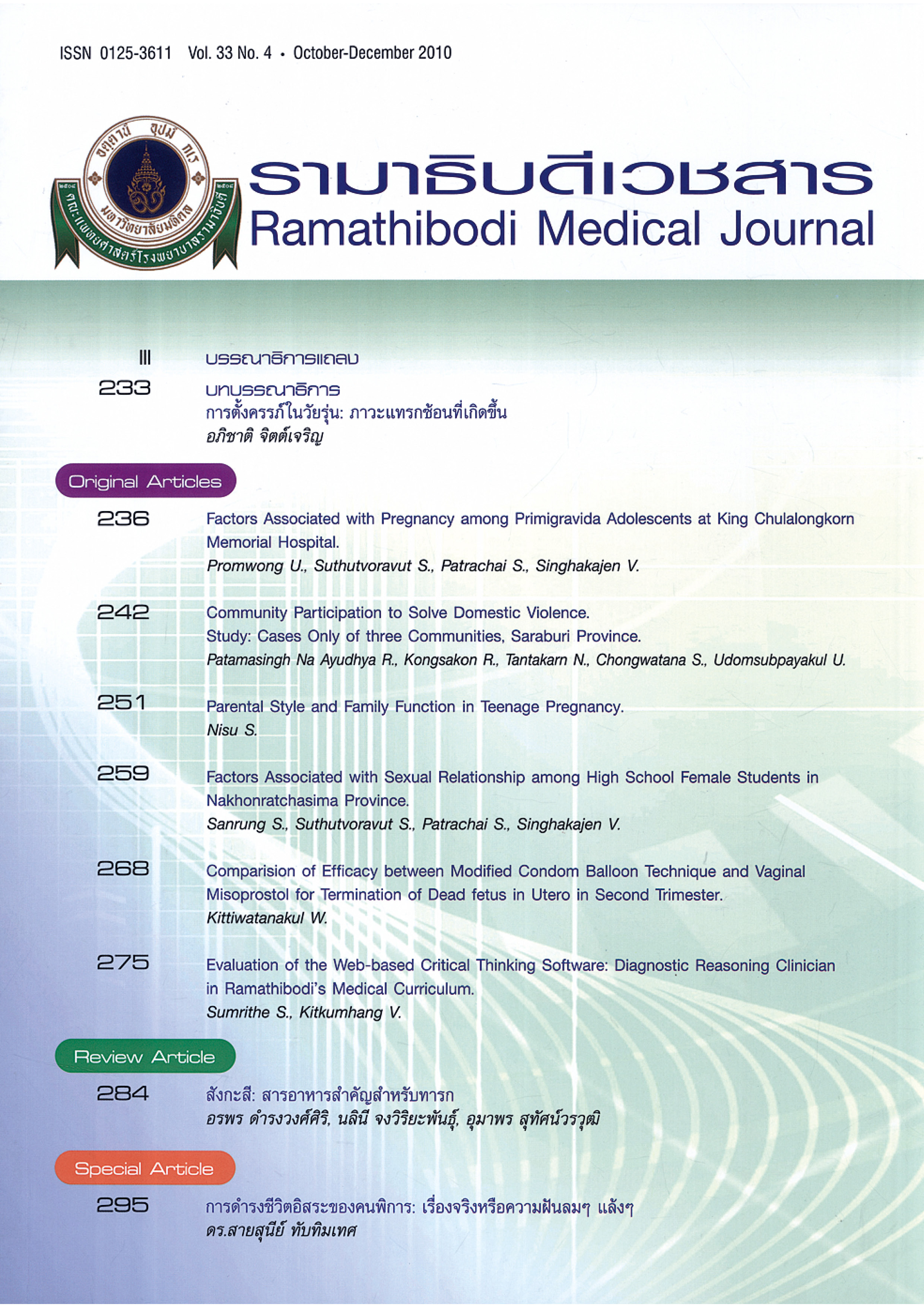Evaluation of the Web-based Critical Thinking Software: Diagnostic Reasoning Clinician in Ramathibodi's Medical Curriculum
Keywords:
Evaluation, Web-based software, Computer program, DxR clinician, Patient simulation, Teaching toolAbstract
Introduction: Clinical reasoning skills are essential for problem-solving process for medical students. DxR Clinician, a web-based critical thinking software, is a computerized case series, in which students learn to gather and interpret data, generate hypotheses and make decisions to solve patient problems. This study aimed to evaluate students' perceptions and satisfactions of DxR Clinician software in the fifth-year medical students at Ramathibodi Hospital, Faculty of Medicine, Mahidol University. Bangkok., Thailand.
Methods: The questionnaires consisted of 33 questions (Likert scale 1-5) with an open response section which were developed to explore students' perceptions and satisfactions of the program. The respondents were 116 medical students who used the computer-based program to practice clinical reasoning skills in family medicine rotation. The data were analyzed by using SPSS program, version 11.5.
Results: Students were found to high satisfaction in the area of feasibility in the use of the program, ability of this program to support the students' clinical reasoning skills and clinical learning. However, they evaluated low satisfaction in term of the ability to stimulate self-directed learning after practicing the program.
Conclusions: The web-based software can be used as an effective educational tool for students to improve their diagnostic skills and refine their knowledge base.
Key words: evaluation, Web-based software, computer program, DxR clinician, patient simulation, teaching tool
References
Ajjawi R, Higgs J. Learning to reason: a journey of professional socialisation. Adv Health Sci Educ Theory Pract. 2008;13(2):133-50. doi:10.1007/s10459-006-9032-4.
Dent JA, Harden RM. A Practical Guide For Medical Teachers. 2nd ed. Edinburgh: Elsevier/Churchill Livingstone; 2005.
Reason J. Human error: models and management. BMJ. 2000;320(7237):768-70. doi:10.1136/bmj.320.7237.768.
Leape LL. Error in medicine. JAMA. 1994;272(23):1851-7.
Helmreich RL. On error management: lessons from aviation. BMJ. 2000;320(7237):781-5. doi:10.1136/bmj.320.7237.781.
Burke CS, Salas E, Wilson-Donnelly K, Priest H. How to turn a team of experts into an expert medical team: guidance from the aviation and military communities. Qual Saf Health Care. 2004;13 Suppl 1(Suppl 1):i96-i104. doi:10.1136/qhc.13.suppl_1.i96.
Turner MK, Simon SR, Facemyer KC, Newhall LM, Veach TL. Web-based learning versus standardized patients for teaching clinical diagnosis: a randomized, controlled, crossover trial. Teach Learn Med. 2006;18(3):208-14. doi:10.1207/s15328015tlm1803_4.
Bearman M, Cesnik B, Liddell M. Random comparison of 'virtual patient' models in the context of teaching clinical communication skills. Med Educ. 2001;35(9):824‐832. doi:10.1046/j.1365-2923.2001.00999.x.
Wayne DB, Butter J, Siddall VJ, Fudala MJ, Wade LD, Feinglass J, et al. Mastery learning of advanced cardiac life support skills by internal medicine residents using simulation technology and deliberate practice. J Gen Intern Med. 2006;21(3):251-6. doi:10.1111/j.1525-1497.2006.00341.x.
Lewis DJ, Sewell RD. Providing formative feedback from a summative computer-aided assessment. Am J Pharm Educ. 2007;71(2):33. doi:10.5688/aj710233.
Cook DA, Thompson WG, Thomas KG, Thomas MR, Pankratz VS. Impact of self-assessment questions and learning styles in Web-based learning: a randomized, controlled, crossover trial. Acad Med. 2006;81(3):231-8. doi:10.1097/00001888-200603000-00005.
McKendree J. E-learning. In : Swanwick T, ed. Understanding Medical Education. Edinburgh, United Kingdom: Association for the Study of Medical Education; 2006:1.
DxR Developmnenl Group. DxR Clinician: Instruclor Manual. Carbondale, Illinois: DxR Development Group, Inc.; 2005.
Kerfoot BP, Armstrong EG, O'Sullivan PN. Interactive spaced-education to teach the physical examination: a randomized controlled trial. J Gen Intern Med. 2008;23(7):973-8. doi:10.1007/s11606-008-0533-0.
Tse MM, Lo LW. A Web-based e-learning course: integration of pathophysiology into pharmacology. Telemed J E Health. 2008;14(9):919-24. doi:10.1089/tmj.2008.0006.
Cohen L, Manion L, Mornison K. Research Methods in Education : Questionnaires. 5th ed. London: Routledge Falmer; 2000:245-66. doi:10.4324/9780203224342.













